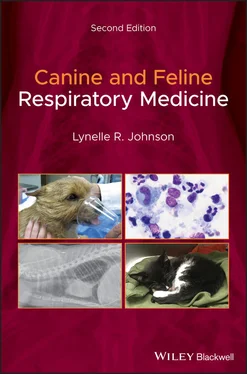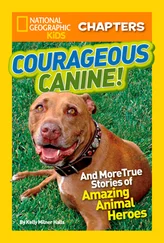Identifiers: LCCN 2019034584 (print) | LCCN 2019034585 (ebook) | ISBN 9781119482284 (hardback) | ISBN 9781119482291 (adobe pdf) | ISBN 9781119482277 (epub)
Subjects: MESH: Respiratory Tract Diseases–veterinary | Dog Diseases–therapy | Dog Diseases–diagnosis | Cat Diseases–therapy | Cat Diseases–diagnosis | Clinical Medicine–methods
Classification: LCC SF992.R47 (print) | LCC SF992.R47 (ebook) | NLM SF 992.R47 | DDC 636.089/62–dc23
LC record available at https://lccn.loc.gov/2019034584LC ebook record available at https://lccn.loc.gov/2019034585
Cover Design: Wiley
Cover Images: Courtesy of Lynelle R. Johnson
This book would not have been possible without the support of my husband and life partner, David Maggs, who will forever be my inspiration in teaching, in research, and in writing.

Students and practicing veterinarians are often challenged by patients with respiratory disease because the clinical signs are so similar among different disease processes within and beyond the respiratory system. Animals with cardiac and systemic diseases often present with respiratory signs, which means that all cases require thought and introspection on appropriate localization of disease as well as the underlying pathophysiology. The most critical piece of the puzzle is a comprehensive respiratory and systemic examination, and this book has been designed to provide easily understood pathways to the diagnosis. It is my hope that this contribution to the veterinary literature conveys highly specific details on respiratory examination, diagnostics, and diseases in a clinically relevant, logical, and easy‐to‐read fashion. This extensively updated edition includes new knowledge that has been generated on respiratory diagnostic testing and diseases such as Norwich terrier upper airway syndrome and epiglottic retroversion.
My goal with this text was to integrate relevant anatomy, physiology, and pathophysiology in a rational and readable manner that is immediately clinically applicable for the busy practitioner and inquiring student. I approached this task recognizing that the major comprehensive textbooks in veterinary medicine contain excellent chapters on respiratory disorders. My book aims to provide an authoritative, cohesive, and complete discussion in a user‐friendly, single‐author volume. The first section deals with the common presenting signs demonstrated by patients with respiratory disease (nasal discharge, loud breathing, cough, tachypnea, and exercise intolerance) as well as a new section on differentiating cardiac from respiratory disease. The next section contains detailed how‐to descriptions of the most important diagnostic methods. I then devote an extensive chapter to therapeutic options, with special reference to new guidelines for management of infectious respiratory diseases. The remainder of the book has thorough explanations of individual diseases, divided into chapters dealing with disorders of the nose, airways, lung parenchyma, pleura, and pulmonary vasculature. Each chapter follows the same easy‐to‐read order, with diseases subdivided by etiology into structural, infectious, inflammatory, and neoplastic disorders.
I hope that this second edition of my textbook will instill confidence in students and practitioners as they identify and manage respiratory conditions of dogs and cats.
I remain grateful to the clients and patients who have both tested and expanded my knowledge.
This work was completed with the support of my colleagues at UC Davis, who have afforded me the opportunity and freedom to pursue respiratory medicine as my passion. Clinicians and house officers in all services have supported my clinical efforts as well as my research, and my departmental colleagues and the School’s leadership have been both encouraging and accommodating
This book is the result of years of discovery and clinical effort, and it would not have been possible without the inspiration from colleagues and collaborators in the USA and worldwide who share a fascination with and great knowledge of respiratory medicine. The veterinarians I have met through the American and European Colleges of Veterinary Internal Medicine and the Veterinary Comparative Respiratory Society have motivated me to continue my search for knowledge.
1 Localization of Disease
Clinical signs that provide clues to the existence of respiratory disease include nasal discharge, cough, respiratory noise, tachypnea, difficulty breathing, or exercise intolerance. The first step in making a diagnosis is the accurate localization of the anatomic origin of disease within the respiratory tract: the nasal cavity, upper or lower airway, lung parenchyma, or pleural space. Achieving appropriate anatomic localization of the site of dysfunction will allow construction of an accurate list of differential diagnoses, will facilitate efficient diagnostic testing, and will allow rational empiric therapy while waiting for test results.
Nasal discharge is almost always a sign of local disease within the nasal cavity. One exception is eosinophilic bronchopneumopathy, an inflammatory condition of the epithelium lining the airways and the lung that can also involve the nasal epithelium. Interestingly, cats with eosinophilic lower airway disease do not display this clinical finding. Nasal discharge can also accompany infectious lower respiratory tract disease in the dog (or occasionally the cat) that coughs airway material into the nasopharynx, which subsequently drains from the nose. Finally, some animals with vomiting or regurgitation will display nasal discharge because of nasopharyngeal regurgitation. This might be more common in brachycephalic breeds, which frequently develop pharyngeal collapse due to increased respiratory effort (Pollard et al. 2018). Brachycephalic animals also are prone to mishandling of food orally due to excessive pharyngeal folds and because of multiple gastrointestinal diseases, including hiatal hernia, gastroesophageal reflux, and mild inflammatory intestinal disease that leads to vomiting or regurgitation. All of these features contribute to nasal discharge in these animals.
The most common respiratory causes of nasal discharge include infectious, inflammatory, and neoplastic disorders as well as dental‐related nasal disease and foreign bodies ( Table 1.1). Additional clinical signs that can be seen in animals with nasal disease include sneezing or reverse sneezing, pawing or rubbing at the face, noisy breathing or mouth breathing, facial pain, or an unexplained odor near the head.
When evaluating the animal with nasal discharge, important considerations include the duration of signs, the type of discharge as well as changes in its character over time, and the presence of unilateral, bilateral, or progressive signs. Acute nasal discharge is often accompanied by sneezing and is most commonly associated with infectious upper respiratory tract disease or a foreign body. Affected animals can have signs that resolve within a week without treatment or they can be so severely affected that animals are rapidly evaluated by a veterinarian to determine a plan for intervention. Occasionally, dogs with nasal foreign bodies will have resolution of signs despite the continued presence of organic matter within the nose. This represents a diagnostic and therapeutic dilemma in the dog that has an appropriate signalment and exposure history for a nasal foreign body, because failure to investigate signs and potentially retrieve a foreign body can have long‐term consequences. The most frustrating cases are those with chronic, slowly progressive nasal discharge and sneezing over weeks to months to years before the severity of disease prompts veterinary care. Prioritizing empiric therapy requires an assessment of the top differential diagnoses and determining what treatment is least likely to worsen signs, to interfere with further diagnostic testing, or to hamper the owner from pursuing specific work‐up.
Читать дальше













